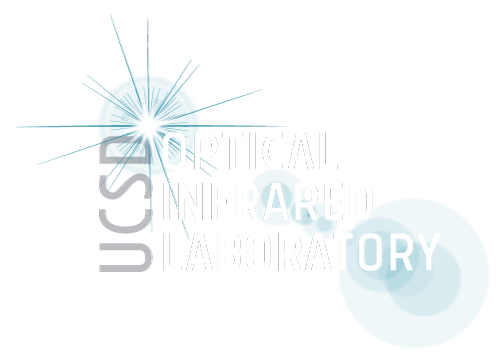| Overview | Science Cases | Simulations | Team |
Summary of Science Cases
Using a near-infrared Integral Field Spectrograph (IFS) and imager fed by next-generation Adaptive Optics, Liger will enable new research in a large variety of astronomy science cases. The science topics illustrated bellow represent the effort of the science team to demonstrate a small portion of the astronomical avenues of research that Liger will explore.
Liger’s higher spectral resolution (right; upper green spectrum) and larger field of view (middle) will enable high-precision measurements for studying fundamental physics in the Galactic Center. Comparison of current Keck OSIRIS IFS observations (35 mas; 8 x 900sec) of the Galactic Center (left) and a Liger lenslet-IFS simulation (31 mas; 8 x 900 sec) collapsed image (middle) shows the much larger number of stars, which also improves astrometric precision. For the late-type star S0-6 (K=14.1 mag), we compare the relative flux of R~3800 OSIRIS observations to that of the R~10,000 spectral resolving power of the Liger IFS at K-band (right). A number of key absorption lines are blended at the resolution of OSIRIS and other current instruments. By cleanly resolving these features, Liger’s R~10,000 mode enables new science, including stellar abundance measurements to understand the mysterious recent star-formation history, and investigating variations in the fine-structure constant in a strong gravitational field around a supermassive black hole.

Liger will explore uncharted parameter space in search of elusive intermediate mass BHs. This will solve one of nature’s great mysteries: how SMBHs came to exist. Liger enables novel searches across a wide range of mass, from stellar mass BHs via astrometric microlensing and binary companions, to intermediate mass BHs in the nuclei of low-mass galaxies. The results will distinguish between current widely differing theories of SMBH formation, such as accretion from Population III stars or direct collapse from supermassive gas clouds (see Greene et al. 2020 for a review).

Liger’s expanded field of view, exquisite sensitivity, and high spectral resolution will be used to characterize the dynamics of high-redshift disk galaxies under formation. (a) The HST image shows a galaxy at z=1.0 with clear spiral features, for which the Hα flux is measured from the 3D-HST survey. The center and right panels show; (b) the expected Hα signal-to-noise ratio from Liger with 2 hours of integration time, and (c) the recovered velocity field for an inclined gaseous disk with σ=20 km/s, with contours showing Hα emission isophotes. This simulation demonstrates that Liger enables efficient mapping of z~1 galaxies, reaching the epoch when the first thin disks are thought to form.
Liger will revolutionize strong gravitational lensing studies of dark matter. Narrow-line emission fluxes in lensed quasar spectra can reveal the presence of low-mass dark matter perturbations. Such a measurement is impossible without AO spectroscopy, given the typical quasar image separations of less than an arcsecond. The middle panel shows simulated Liger data of SDSS J0924 with 5400 s exposure time, along with the smaller FOV for OSIRIS observations of this system (Nierenberg et al. 2014). Liger’s FOV enables the entire lens to be imaged in a single pointing, reducing uncertainty in flux ratios and increasing sensitivity to low-mass dark-matter substructure via improved astrometry. The right panel shows the measured spectrum (in photons/s/μm) for the faintest source, D. Liger’s higher throughput and spectral resolution increase S/N in the narrow-line [N II] emission by a factor of 5, and enables the detection of [S II], providing sensitivity to lower-mass dark-matter halos. Simultaneously, Liger will provide resolved stellar kinematics of the lensing galaxies for improved mass modeling. This removes the dominant uncertainty on lensing time-delay measurements of the Hubble constant, a unique approach to determine the nature of dark energy.

Liger will transform our understanding of exoplanet formation with excellent performance and resolution reaching shorter wavelengths than any other current or planned instruments. (Left) Liger S/N map of four simulated planets, similar to the HR 8799. The simulation uses an atmospheric model with Teff =900 K, g=56 and solar metallicity (Sonora, Marley et al. 2018). Increasing the resolution from R=4000 to R=10000 increases the detection S/N by at least a factor of 2. (Right) Atmospheric models with three different enrichments of heavy elements, showing the dramatic impact of metallicity on the depth of those features, in particular the prominent potassium (KI) lines. Other lines in this region are attributable to FeH or H2O, which are also clearly metallicity dependent.
